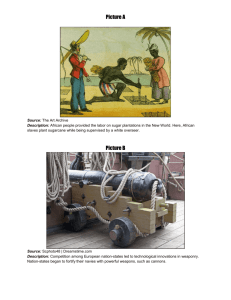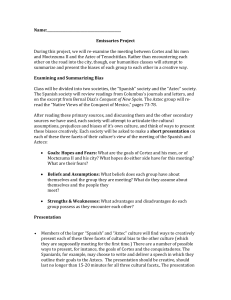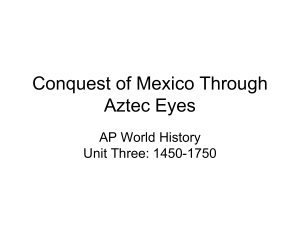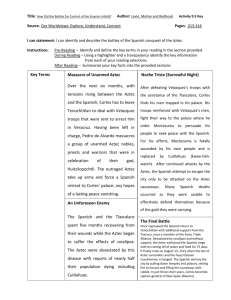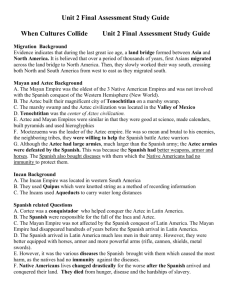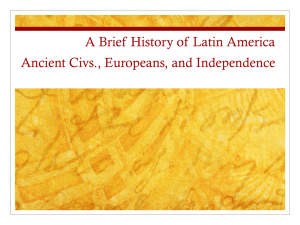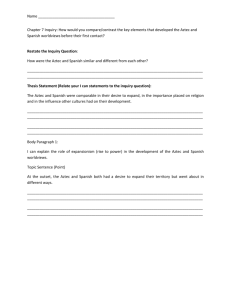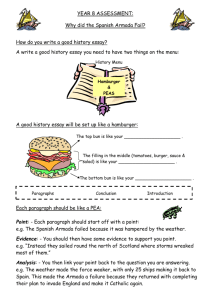Cortes & Montezuma, 1519
advertisement
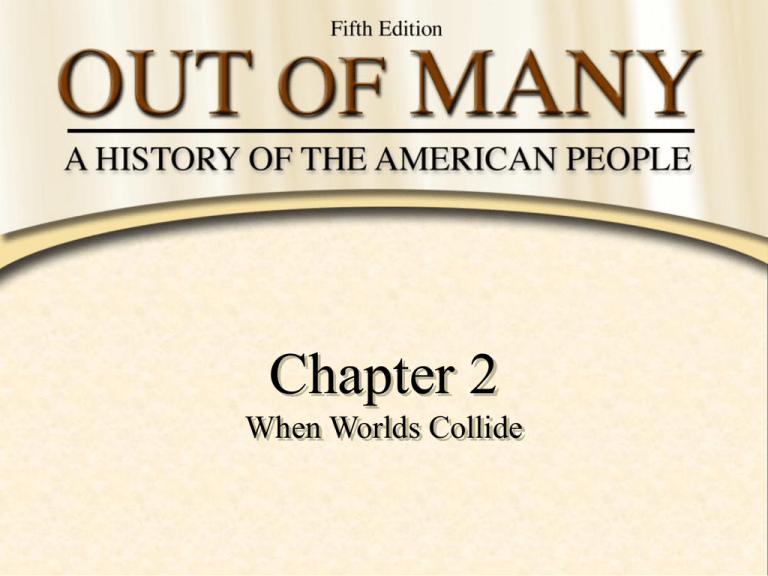
Chapter 2 When Worlds Collide MAP 2.1 Western Europe in the Fifteenth Century By the middle of the century, the monarchs of western Europe had unified their realms and begun to build royal bureaucracies and standing armies and navies. These states, all with extensive Atlantic coastlines, sponsored the voyages that inaugurated the era of European colonization. MAP 2.2 The Invasion of America In the sixteenth century, the Spanish first invaded the Caribbean and used it to stage their successive wars of conquest in North and South America. In the seventeenth century, the French, English, and Dutch invaded the Atlantic coast. The Russians, sailing across the northern Pacific, mounted the last of the colonial invasions in the eighteenth century. MAP 2.3 European Exploration, 1492–1591 By the mid-sixteenth century, Europeans had explored most of the Atlantic coast of North America and penetrated into the interior in the disastrous expeditions of de Soto and Coronado. FIGURE 2.1 North America’s Indian and Colonial Populations in the Seventeenth and Eighteenth Centuries The primary factor in the decimation of native peoples was epidemic disease, brought to the New World from the Old. In the eighteenth century, the colonial population overtook North America’s Indian populations. SOURCE:Historical Statistics of the United States (Washington,DC: Government Printing Office,1976),8,1168;Russell Thornton, American Indian Holocaust and Survival (Norman:University of Oklahoma Press,1987),32. FIGURE 2.2 The African, Indian, and European Populations of the Americas In the 500 years since the European invasion of the Americas, the population has included varying proportions of Native American, European, and African peoples, as well as large numbers of persons of mixed ancestry. SOURCE:Colin McEvedy and Richard Jones,Atlas of World Population History (New York:Penguin,1978),280. A French peasant labors in the field before a spectacular castle in a page taken from the illuminated manuscript Tres Riches Heures, made in the fifteenth century for the duc de Berry. In 1580 the essayist Montaigne talked with several American Indians at the French court who “noticed among us some men gorged to the full with things of every sort while their other halves were beggars at their doors, emaciated with hunger and poverty” and “found it strange that these poverty-stricken halves should suffer such injustice, and that they did not take the others by the throat or set fire to their houses.” SOURCE:Photograph by Giraudon,Art Resource,N.Y. A central figure in this development was the king’s son, Prince Henry, known to later generations as “the Navigator.” In the spirit of Renaissance learning, the prince established an academy of eminent geographers, instrument makers, shipbuilders, and seamen at his institute at The astrolabe, an instrument used for determining the precise position of heavenly bodies was introduced into early modern Europe by the Arabs. This is one of the earliest examples, an intricately-engraved brass astrolabe produced by a master craftsman in Syria in the thirteenth century. SOURCE:Smithsonian Museum,DC This ship, thought to be similar to Columbus’s Niña, is a caravel, a type of vessel developed by the naval experts at Henry the Navigator’s institute at Sagres Point in Portugal. To the traditional square-rigged Mediterranean ship, they added the “lateen” sail of the Arabs, which permitted much greater maneuverability. Other Asian improvements, such as the stern-post rudder and multiple masting, allowed caravels to travel farther and faster than any earlier ships, and made possible the invasion of America. SOURCE:Drawing by Bjorn Landstrom from The Ship .Dell Publishing. This image accompanied Columbus’s account of his voyage, which was published in Latin and reissued in many other languages and editions that circulated throughout Europe before 1500. The Spanish King Ferdinand is shown directing the voyage to a tropical island, where the natives flee in terror. Columbus’s impression of Native Americans as a people vulnerable to conquest shows clearly in this image. SOURCE:The Granger Collection. This map of Tenochititlan, published in 1524 and attributed to the celebrated engraver Albrecht Dürer, shows the city before its destruction, with the principal Aztec temples in the main square, cause-ways connecting the city to the mainland, and an acqueduct supplying fresh water. The information on this map must have come from Aztec sources, as did much of the intelligence Cortés relied on for the Spanish conquest. The Cruelties Used by the Spaniards on the Indians, from a 1599 English edition of The Destruction of the Indies by Bartolomé de las Casas. These scenes were copied from a series of engravings produced by Theodore de Bry that accompanied an earlier edition. SOURCE:British Library. This drawing of victims of the smallpox epidemic that struck the Aztec capital of Tenochtitlán in 1520 is taken from the Florentine Codex, a postconquest history written and illustrated by Aztec scribes. “There came amongst us a great sickness, a general plague,” reads the account, “killing vast numbers of people. It covered many all over with sores: on the face, on the head, on the chest, everywhere. . . . The sores were so terrible that the victims could not lie face down, nor on their backs, nor move from one side to the other. And when they tried to move even a little, they cried out in agony.” SOURCE:The Granger Collection. This watercolor of Jacques le Moyne, painted in 1564, depicts the friendly relations between the Timucuas of coastal Florida and the colonists of the short-lived French colony of Fort Caroline. The Timucuas hoped that the French would help defend them against the Spanish, who plundered the coast in pursuit of Indian slaves. SOURCE:Jacques Le Moyne,Rene de Loudonniere and Chief Athore ,1564 (watercolor),The New York Public Library,New York. The French, under the command of Jean Ribault, land at the mouth of the St. Johns River in Florida. The image shows the local Timucua people welcoming the French, It is likely that the Timucuas viewed the French as potential allies against the Spanish, who had plundered the coast many times in pursuit of slaves. SOURCE:Colored engraving,1591,by Theodor de Bry after a now lost drawing by Jacques Le Moyne de Morgues;The Granger Collection. The Armada Portrait of Elizabeth I, painted by an unknown artist in 1648. The queen places her hand on the globe, symbolizing the rising seapower of England. Through the open windows, we see the battle against the Spanish Armada in 1588 and the destruction of the Spanish ships in a providential storm, interpreted by the queen as an act of divine intervention. SOURCE:Elizabeth I ,Armada portrait,ca.1588 (oil on panel),by English School.Private collection/The Bridgeman Art Library International,Ltd. The care that John White brought to his painting is evident in this watercolor of an Algonquian mother and daughter (1585). The woman’s fringed deerskin skirt is edged with white beads,and the decoration on her face and upper arms seems to be tattooed. The little wooden doll in the girl’s hand was a gift from White. All the Indian girls, wrote Thomas Harriot, “are greatly dellighted with puppetts and babes which were brought out of England.” SOURCE:John White (1570 –93),“Woman and Child of Pomeiooc.” Watercolor.British Museum,London.The Bridgeman Art Library International Ltd.
